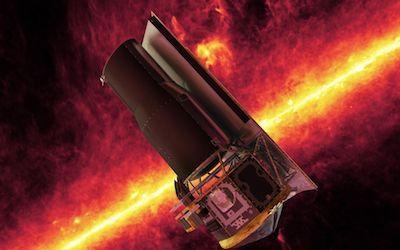Tue, Nov 07, 2017
Posts Request For Information From Commercial Companies Interested In Operating The Spacecraft
NASA's Science Mission Directorate (SMD) is seeking information from parties who are interested in operating the Spitzer Space Telescope using non-NASA funding, including defining and executing a Spitzer science program, beyond the timeframe of the NASA-funded mission.

According to a Request for Information (RFI) posted to the GSA website, the Astrophysics Division of SMD has committed support for Spitzer operations through March 2019. If no engineering impediments arise, the agency estimates that current Spitzer operations could continue through September 2019 and operations beyond September 2020 should be possible for the lowest data volume observing modes. The FY18 cost of Spitzer operations, without direct science data analysis funding for the Guest Observer (GO) program and Deep Space Network (DSN) support, is $14 million. Responses to this Request for Information are sought from all interested domestic parties.
The Spitzer Space Telescope was launched in 2003 as NASA's Great Observatory for infrared exploration of the Universe, and the prime mission was completed in mid-2009 after the exhaustion of the on-board cryogen. Since that time the observatory has operated with the two shortest wavelength arrays of the Infrared Array Camera (IRAC) at 3.6 and 4.5 µm. IRAC performance continues to be excellent. As Spitzer progresses along its Earth trailing orbit the geometry between the observatory, the Sun, and the Earth changes in such a way that in order to point the body-fixed high-gain antenna for communications, the observatory has to orient to greater solar pitch angles. Ensuring safe and efficient operations under these conditions poses the main challenge to prolonged operations.
While the upcoming James Webb Space Telescope's capabilities will exceed Spitzer's for most observing programs, Spitzer's demonstrated relative photometry precision, mapping speed and ability to make very long observations, interrupted only by downlinks every 24-48 hours, still provide unique capabilities for studies of exoplanets, extragalactic surveys and other science programs that benefit from its unique attributes.
However, the agency points out that an RFI is NOT a Request for Proposal, nor Invitation for Bid. This RFI is being used to obtain information for planning purposes only, and the Government does not intend to award a contract at this time.
(Source: GSA website. Image from file)
More News
With Testing Soon Complete, Launch Preparations Begin in Earnest Sierra Space's Dream Chaser has been put through the wringer at NASA's Glenn Armstrong Test Facility in Ohio, but w>[...]
Takeoff Roll The process whereby an aircraft is aligned with the runway centerline and the aircraft is moving with the intent to take off. For helicopters, this pertains to the act>[...]
“We’re proud of the hard work that went into receiving this validation, and it will be a welcome relief to our customers in the European Union. We couldn’t be mor>[...]
"Aircraft Spruce is pleased to announce the acquisition of the parts distribution operations of Wag-Aero. Wag-Aero was founded in the 1960’s by Dick and Bobbie Wagner in the >[...]
IDENT Feature The special feature in the Air Traffic Control Radar Beacon System (ATCRBS) equipment. It is used to immediately distinguish one displayed beacon target from other be>[...]
 Sierra Space Repositions Dream Chaser for First Mission
Sierra Space Repositions Dream Chaser for First Mission ANN's Daily Aero-Term (05.10.24): Takeoff Roll
ANN's Daily Aero-Term (05.10.24): Takeoff Roll Aero-News: Quote of the Day (05.10.24)
Aero-News: Quote of the Day (05.10.24) Aero-News: Quote of the Day (05.11.24)
Aero-News: Quote of the Day (05.11.24) ANN's Daily Aero-Term (05.11.24): IDENT Feature
ANN's Daily Aero-Term (05.11.24): IDENT Feature



